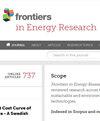Testing the environmental Kuznets Curve hypothesis at the sector level: Evidence from PNARDL for OECD countries
IF 2.6
4区 工程技术
Q3 ENERGY & FUELS
引用次数: 0
Abstract
Since the contribution of economic sectors to GDP is heterogeneous, they also contribute differently to CO2 emissions and environmental degradation. In this regard, it is crucial to examine the Environmental Kuznets Curve (EKC) hypothesis at the sectoral level. Nevertheless, despite the extensive research conducted on the Environmental Kuznets Curve (EKC) hypothesis, significant gaps remain in the existing literature, particularly at the sectoral level. This study makes a novel contribution to the existing literature on the environmental EKC hypothesis by examining its validity across four distinct sectors: agriculture, industry, manufacturing, and services. Additionally, it makes a second contribution to the literature by examining the effect of energy consumption on CO2 asymmetrically, employing a novel panel non-linear ARDL (PNARDL) method. The study employs annual data from 38 OECD countries, spanning the period from 1990 to 2022. The findings demonstrate that the EKC hypothesis is valid for sectors other than the industrial sector and for the economy as a whole. The turning point of the Kuznets Curve for the total economy is estimated as $29250 GDP在部门层面检验环境库兹涅茨曲线假设:经合组织国家 PNARDL 的证据
由于各经济部门对国内生产总值的贡献不同,它们对二氧化碳排放和环境退化的贡献也不同。因此,在部门层面研究环境库兹涅茨曲线(EKC)假说至关重要。然而,尽管对环境库兹涅茨曲线(EKC)假说进行了广泛的研究,但现有文献中仍存在重大空白,尤其是在部门层面。本研究通过考察农业、工业、制造业和服务业这四个不同部门的环境库兹涅茨曲线假说的有效性,为环境库兹涅茨曲线假说的现有文献做出了新的贡献。此外,本研究还采用了一种新颖的面板非线性 ARDL(PNARDL)方法,以非对称的方式研究了能源消耗对二氧化碳的影响,从而为相关文献做出了第二项贡献。研究采用了 38 个经合组织国家的年度数据,时间跨度为 1990 年至 2022 年。研究结果表明,EKC 假设对工业部门以外的其他部门和整个经济都是有效的。总体经济的库兹涅茨曲线转折点估计为人均国内生产总值 29250 美元。PNARDL 模型的误差修正项(ect)为负且显著。然而,该项的大小表明,在受到任何冲击后,系统将在大约 2.87 年后恢复长期均衡。非对称效应对四个部门都有效。此外,实证结果清楚地表明,能源消耗对排放的长期和短期影响是不对称的。从长期来看,能源消耗的正向和负向冲击都会增加经合组织经济体的二氧化碳排放量。经确定,农业是增加二氧化碳排放量从而导致环境退化最严重的部门。这种情况凸显了农业部门生产性资本设备和可再生能源的有限性,即使在经合组织国家也是如此。因此,研究结果表明,每个部门的国内生产总值与二氧化碳排放量之间存在不同的关系。决策者必须制定针对具体部门的政策,在促进国内生产总值增长的同时减少二氧化碳排放量。
本文章由计算机程序翻译,如有差异,请以英文原文为准。
求助全文
约1分钟内获得全文
求助全文
来源期刊

Frontiers in Energy Research
Economics, Econometrics and Finance-Economics and Econometrics
CiteScore
3.90
自引率
11.80%
发文量
1727
审稿时长
12 weeks
期刊介绍:
Frontiers in Energy Research makes use of the unique Frontiers platform for open-access publishing and research networking for scientists, which provides an equal opportunity to seek, share and create knowledge. The mission of Frontiers is to place publishing back in the hands of working scientists and to promote an interactive, fair, and efficient review process. Articles are peer-reviewed according to the Frontiers review guidelines, which evaluate manuscripts on objective editorial criteria
 求助内容:
求助内容: 应助结果提醒方式:
应助结果提醒方式:


